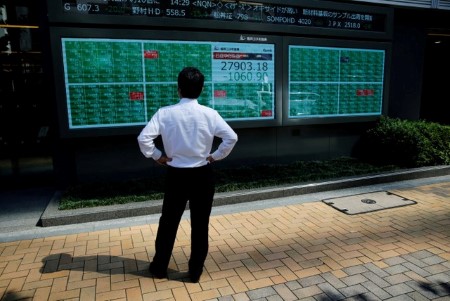




Policy Rate Updates: Double cut finale
 DOWNLOAD
DOWNLOAD

Monthly Economic Update: One for the road
 DOWNLOAD
DOWNLOAD

Inflation Update: Still low, still slow
 DOWNLOAD
DOWNLOAD


Stocks drift, oil slumps on recession fears

SINGAPORE, Aug 16 (Reuters) – Asian markets struggled for direction on Tuesday, weighed by worries over global growth following weak China data that knocked oil prices and commodity-linked currencies.
The dollar held near a one-week high as investors piled back into the safe-haven currency, while the Aussie, euro and Chinese yuan buckled.
MSCI’s broadest index of Asia-Pacific shares outside Japan ticked up 0.2%, recovering from Monday’s losses. MSCI’s benchmark index has gained 5% from the year’s lows but is still down 15% so far this year.
Just as investors were taking heart from a four-week rally in global equities that pushed markets to their highest in more than three months, Monday’s underwhelming Chinese activity data spanning industrial output and retail sales hit sentiment.
Also, US single-family homebuilders’ confidence and New York state factory activity fell in August to their lowest since near the start of the COVID-19 pandemic, a further sign the world’s largest economy is softening as the Federal Reserve raises interest rates.
“In short, the risks of a global recession are suddenly much clearer. Then again, they were ‘always’ clear to some,” Rabobank said in a note. “And does anyone think that a central-bank pivot will make them less likely at this stage?”
Overall, the picture was mixed across Asian bourses on Tuesday, with Tokyo and Taiwan benchmarks little changed, while South Korean stocks gained 0.5%.
Chinese stocks rose, a day after the central bank unexpectedly cut interest rates after data showed economic activity and credit expansion slowed sharply in July. The CSI 300 index ticked up 0.1% after dipping on Monday.
On Wall Street, major indexes climbed on Monday, reversing earlier session losses. Shares posted four straight weeks of gains amid optimism over a slowdown in US inflation that could temper the pace of Fed rate hikes.
The US economy contracted in the first and second quarters, amplifying an ongoing debate over whether the country is, or will soon be, in recession.
Growth worries were also the dominant theme in Europe.
Euro zone government bond yields fell on Monday with investors concerned about possible recession and amid persistent fears of production cuts in Germany due to potential gas rationing.
On Tuesday, the dollar index, which measures the greenback against six major peers, held steady at 106.53, just below the previous session’s peak of 106.55, the strongest since Monday of last week.
The euro, the most heavily weighted currency in the dollar index, was flat at USD 1.0158 after earlier slipping to the weakest since Aug. 5 at 1.0154.
The Australian dollar fell as low as USD 0.70005, threatening to drop below the psychological 70 cent mark for the first time since Wednesday. New Zealand’s kiwi slipped to USD 0.6349, also the lowest since Wednesday.
Fragile demand outlook hit oil prices as they extended losses from the previous session.
Brent crude futures lost 1% to USD 94 a barrel after falling to their lowest on Monday since before Russia sent troops into Ukraine on Feb. 24. WTI crude futures shed 0.7% to USD 88.80 a barrel.
(Editing by Jacqueline Wong)
This article originally appeared on reuters.com





 By Reuters
By Reuters